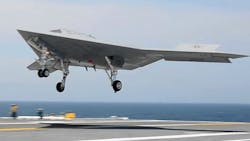Navy asks industry to develop sensors and communications to enable unmanned aircraft to land on carriers
ARLINGTON, Va. – U.S. Navy unmanned aircraft researchers are asking industry to develop precise sensors and communications systems to enable unmanned aerial vehicles (UAVs) to land safely aboard aircraft carriers in electronic jamming, bad weather, and other harsh conditions.
Officials of the Office of Naval Research in Arlington, Va., released a broad agency announcement (N00014-21-S-SN02) on Monday for the Landing Autonomous Navigation Technology for Enhanced Recovery to Navy Ships (LANTERNS) project to improve communications between ships and aircraft.
LANTERNS seeks to develop and demonstrate an advanced landing system to improve unmanned air operations in contested environments, and move these technologies into naval aviation programs of record as soon as possible.
Navy leaders say they plan to field an unmanned carrier-based capability in the mid-2020s for refueling and high-endurance intelligence, surveillance, and reconnaissance (ISR) capability. These UAVs must be able to land safely aboard aircraft carriers in permissive and contested environments.
Related: Sensor payloads for unmanned vehicles
Autonomous landings rely on accurate measurements of UAV and aircraft carrier positions, headings, and similar information. Sensors can get this information by measuring aircraft and ship position, heading, pitch, roll, yaw, heave, and sway.
Measuring these different movements can come either from GPS and inertial measurement units on each aircraft and ship, or from measuring the relative position and heading of the UAV with a high-accuracy sensor onboard the aircraft carrier. For either of these two techniques to work, two-way communications are necessary, which will require advanced new technologies.
To do this, Navy researchers are asking industry to develop a precision ship-relative navigation solution that meets demanding datalink bandwidth and range goals using antennas and radios for UAVs and aircraft carriers that integrate into the carrier-based Joint Precision Approach and Landing System (JPALS).
Companies interested should submit full proposals no later than 30 Sept. 2021 online at FedConnect at www.fedconnect.net.
Email technical questions to David Findlay, the LANTERNS program officer, at [email protected], or Zachary Sechrist at [email protected]. Email business questions to James Farnsworth at [email protected].
More information is online at https://beta.sam.gov/opp/9e3d71c823584efcada680b47fe7a16d/view.
